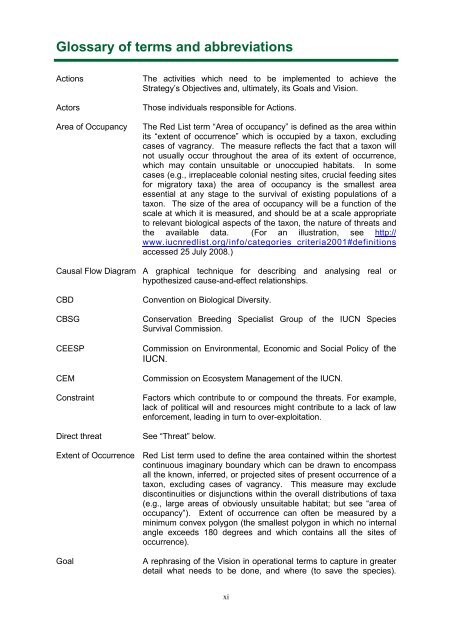Strategic Planning for Species Conservation: A Handbook - IUCN
Strategic Planning for Species Conservation: A Handbook - IUCN
Strategic Planning for Species Conservation: A Handbook - IUCN
You also want an ePaper? Increase the reach of your titles
YUMPU automatically turns print PDFs into web optimized ePapers that Google loves.
Glossary of terms and abbreviations<br />
xi<br />
Glossary<br />
Actions The activities which need to be implemented to achieve the<br />
Strategy’s Objectives and, ultimately, its Goals and Vision.<br />
Actors Those individuals responsible <strong>for</strong> Actions.<br />
Area of Occupancy The Red List term “Area of occupancy” is defined as the area within<br />
its “extent of occurrence” which is occupied by a taxon, excluding<br />
cases of vagrancy. The measure reflects the fact that a taxon will<br />
not usually occur throughout the area of its extent of occurrence,<br />
which may contain unsuitable or unoccupied habitats. In some<br />
cases (e.g., irreplaceable colonial nesting sites, crucial feeding sites<br />
<strong>for</strong> migratory taxa) the area of occupancy is the smallest area<br />
essential at any stage to the survival of existing populations of a<br />
taxon. The size of the area of occupancy will be a function of the<br />
scale at which it is measured, and should be at a scale appropriate<br />
to relevant biological aspects of the taxon, the nature of threats and<br />
the available data. (For an illustration, see http://<br />
www.iucnredlist.org/info/categories_criteria2001#definitions<br />
accessed 25 July 2008.)<br />
Causal Flow Diagram A graphical technique <strong>for</strong> describing and analysing real or<br />
hypothesized cause-and-effect relationships.<br />
CBD Convention on Biological Diversity.<br />
CBSG <strong>Conservation</strong> Breeding Specialist Group of the <strong>IUCN</strong> <strong>Species</strong><br />
Survival Commission.<br />
CEESP Commission on Environmental, Economic and Social Policy of the<br />
<strong>IUCN</strong>.<br />
CEM Commission on Ecosystem Management of the <strong>IUCN</strong>.<br />
Constraint Factors which contribute to or compound the threats. For example,<br />
lack of political will and resources might contribute to a lack of law<br />
en<strong>for</strong>cement, leading in turn to over-exploitation.<br />
Direct threat See “Threat” below.<br />
Extent of Occurrence Red List term used to define the area contained within the shortest<br />
continuous imaginary boundary which can be drawn to encompass<br />
all the known, inferred, or projected sites of present occurrence of a<br />
taxon, excluding cases of vagrancy. This measure may exclude<br />
discontinuities or disjunctions within the overall distributions of taxa<br />
(e.g., large areas of obviously unsuitable habitat; but see “area of<br />
occupancy”). Extent of occurrence can often be measured by a<br />
minimum convex polygon (the smallest polygon in which no internal<br />
angle exceeds 180 degrees and which contains all the sites of<br />
occurrence).<br />
Goal A rephrasing of the Vision in operational terms to capture in greater<br />
detail what needs to be done, and where (to save the species).

















